DORAEMON : MEIKYŪ DAISAKUSEN
( Cratermaze )
|
|

|

|
|
ドラえもん 迷宮大作戦
©1989 Hudson Soft / vol.22
©Fujiko Shogakukan TV Asahi
Release : 1989-10-31 (¥4900)
HuCard (4 Mbits) HC89023
Backup Ram
Action / Puzzle game
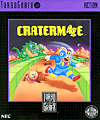

|
Released in America as
CRATERMAZE
( TGX020027 )
|
|
Doraemon Meikyū Daisakusen is an action/puzzle game
by Hudson Soft and based on the highly popular anime
and manga character Doraemon. The young Nobi and his friends
are your usual Japanese school boys. But, thanks to the genius and enigmatic Doraemon,
they are also time travelers and spend most of their time exploring time periods,
from the dangerous and wild Jurassic period
to robotic-cities of the future. But things do not always go according to
plans and one day, during a short time-escapade,
a mysterious evil entity appears and kidnaps the children.
Doraemon's mission is now to travel through time and to rescue them.
The goal of the game is to collect all the yummy hamburgers
scattered around each level/maze and to find the key that leads to the next
stage. A whole legion of enemies, of course, try to stop Doraemon and
he has only one weapon against this onslaught - digging holes in the
ground. When an enemy falls into one, Doraemon must
fill it up as quickly as possible in order to dispose of the bothersome foe.
Once defeated, enemies will drop all kind of special icons - these
power-ups only work for a short amount of time though, and they
range from an invisibility helmet, speed-up rollerskates
or weapons such as the Freezing-gun or the incredible Yo-Yo.
Doraemon Meikyū Daisakusen apparently consists of sixty
mazes and each fifteen level reveals one of the kidnaped children.
|
Teaser text from the American version:
The evil Kublai from Zenzombie land, has kidnaped four of your friends as you
time-traveled on a magic carped. Now you must rescue them. But run for your life !
You're in a maze of monsters! Hit them with your Yoyo! Dig a hole so they'll fall in!
Shoot them with your Freeze Beam! Kill them dead with your Bubble Gun! There are 60
incredible levels of action. So wear your helmet and watch your step!
|
|
The funny looking robot-cat was created by
Fujimoto Hiroshi (Fujiko F. Fujio) and Motoo Abiko (Fujiko Fujio A)
back in the 1970s. The series started as a manga and featured a glasses-wearing
boy named Nobi Nobita. The story starts as his great-great grandson from the 22nd century decides to
send him a cat-shaped robot from the future to teach him how to become a smart kid.
Because of Nobita's extreme laziness, his descendants live in poverty and they see
in the robot-cat named "Doraemon" a way to change their own fate...
Doraemon is a likable and stunningly resourceful robot - he
always uses tons of smart gadgets and crazy devices that he effortlessly pull from his
'4-dimensional front pocket'. The most popular one is the Dokodemo Doa, a special
door allowing him (and guests) to travel anywhere in time.
The series also stars other kids, such as Shizuka (nice
girl and Nobita's best friend), Gian (the bully) and Suneo (the rich kid).
Doraemon is easily one of the most popular and beloved cartoon
character in Japan.
|

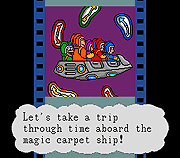
|
Once again, the American version of the game, renamed Cratermaze,
was highly edited. The blue robot-cat was obliterated and replaced
by a human kid in a blue space-suit. This kind of make sense, Doraemon,
even today, is not very known by players in the west. Most of
the introduction sequence is also different (the title screen features
a kid being chased by a green dinosaur), and various elements
were completely changed too (they are not flying a magic-carpet
anymore, but a space-ship). Interestingly, the magic-carpet element
is still present in the translated text and became the name of
the ship. Finally, the main character doesn't
collect hamburgers, but red treasure chests. Overall, the graphics
quality is nevertheless very good and very close to the original game.
|
Interestingly, the American version is actually one step closer
to the truth behind Doraemon Meikyū Daisakusen. Let me explain.
Nichibutsu released in 1987 an arcade game called Kid
no Hore Hore Daisakusen (aka Booby Kids), and this exclusively in Japan.
The game, pictured on the right,
stars a kid in a blue space suit wondering around mazes, and the goal of game is
to collect red treasure chests and to dig holes in the ground. Sounds familiar?
The game is virtually identical to
Doraemon Meikyū Daisakusen, or more precisely, to Cratermaze (notice
the blue space suit and also the dinosaur on the game's title screen).
I wonder if Hudson Soft didn't originally develop a port of
Kid no Hore Hore Daisakusen for the PC Engine system, and the Doreamon
franchise came later. So they maybe re-used the graphics for the American Turbografx-16 version.
In all cases, Doraemon Meikyū Daisakusen is
definitively based on Nichibutsu's Kid no Hore Hore Daisakusen.
As a final side note, Kid no Hore Hore Daisakusen was converted to
the Famicom system in 1987 as Booby Kids (pictured on the right).
|
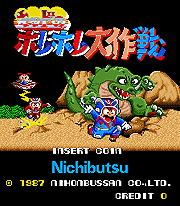
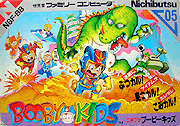
|
|
O
M
A
K
E
|
|
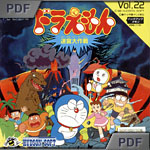
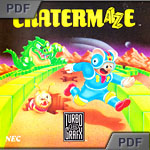
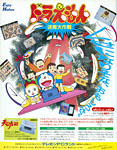
|
|
|
Click on picture to enlarge |
|
|
|
LK

|
|
Add your Pov here !
|
P
O
V
s
|
|
Doraemon Meikyū Daisakusen is a nice little game and is
the first of two games to feature Doreamon for the PC Engine system.
I personally prefer the other one (the platform game), Meikyū Daisakusen being only a
simple mixture between Bomberman and Space Panic (but not as fun as neither of them).
Graphics are cute and well drawn, and there are enough power-ups to keep you
busy for a while. But the mazes all look alike
and the game quickly becomes a repetitive affair... it is also
rather easy and not very challenging. So, all in all,
there is nothing particularly bad about Doraemon Meikyū Daisakusen,
but I just feel that a lot more could have been done with it.
|
|
|
|